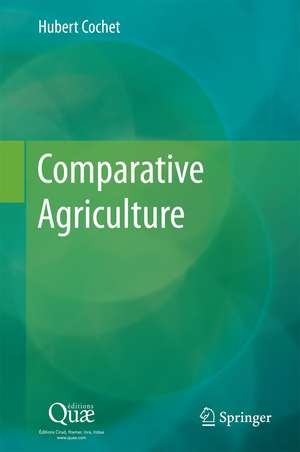Comparative Agriculture
Autor Hubert Cocheten Limba Engleză Hardback – 4 mai 2015
| Toate formatele și edițiile | Preț | Express |
|---|---|---|
| Paperback (1) | 548.91 lei 38-44 zile | |
| SPRINGER NETHERLANDS – 23 oct 2016 | 548.91 lei 38-44 zile | |
| Hardback (1) | 640.24 lei 6-8 săpt. | |
| SPRINGER NETHERLANDS – 4 mai 2015 | 640.24 lei 6-8 săpt. |
Preț: 640.24 lei
Preț vechi: 753.22 lei
-15% Nou
Puncte Express: 960
Preț estimativ în valută:
122.55€ • 133.16$ • 103.01£
122.55€ • 133.16$ • 103.01£
Carte tipărită la comandă
Livrare economică 21 aprilie-05 mai
Preluare comenzi: 021 569.72.76
Specificații
ISBN-13: 9789401798273
ISBN-10: 9401798273
Pagini: 200
Ilustrații: XI, 154 p. 10 illus., 9 illus. in color.
Dimensiuni: 155 x 235 x 15 mm
Greutate: 0.41 kg
Ediția:2015
Editura: SPRINGER NETHERLANDS
Colecția Springer
Locul publicării:Dordrecht, Netherlands
ISBN-10: 9401798273
Pagini: 200
Ilustrații: XI, 154 p. 10 illus., 9 illus. in color.
Dimensiuni: 155 x 235 x 15 mm
Greutate: 0.41 kg
Ediția:2015
Editura: SPRINGER NETHERLANDS
Colecția Springer
Locul publicării:Dordrecht, Netherlands
Public țintă
ResearchCuprins
Introduction.- SECTION ONE: THEORETICAL APPROACH TO COMPARATIVE AGRICULTURE.- Chapter 1. Comparative agriculture, Object and Issues.- Chapter 2. The Origins of Comparative agriculture and René Dumont’s Legacy.- Chapter 3. “Agrarian System”, Integrating Concept of Comparative agriculture.- Chapter 4. Diachronic Approach to Agrarian Systems.- Chapter 5. Comparing Productive Processes.- SECTION TWO: METHODS AND EXPERTISE OF COMPARATIVE AGRICULTURE.- Chapter 6. Micro-Regional Approach to Agrarian Issues.- Chapter 7. Terrain and Surveys.- Chapter 8. Making History in Comparative agriculture.- Chapter 9. How to Build Farm Typologies?.- Chapter 10. Economy of Agricultural Production Process.- Chapter 11. Comparative agriculture and Evaluation.- Conclusion.- Bibliography.
Textul de pe ultima copertă
How to define comparative agriculture? What can it offer to the analysis of agrarian realities and agricultural development processes? How did it become a driving force behind the proposals at the service of sustainable development?
In the footsteps of René Dumont, Hubert Cochet offers a thorough analysis of comparative agriculture, based on twenty-five years of research and teaching carried out on site in France, as well as in many countries in Latin-America, Africa, Asia and Europe.
In the first section dedicated to theoretical thoughts on comparative agriculture, Hubert Cochet introduces the notion of “agricultural development”, the very subject of comparative agriculture, with a restored endogenous dimension. He then describes how this approach was slowly consolidated, around the concept of agrarian system in particular. The comparison of agricultural transformations in time and space highlights the importance of the comparatist approach to production processes, their trajectories and differentiation on a worldwide scale.
The second section which focuses on the methods and expertise of comparative agriculture, tackles the issues of landscape analysis, field surveys and the historical approach underlying comparative agriculture. It sums up the economic tools mobilised as well as the evaluation perspectives opened up by comparative agriculture.
This book which is at the crossroad of the social and life sciences, is meant for all those who wonder about the transformations of agriculture around the world, and who wish to change its course in the interest of the great majority.
Agricultural Economist and Geographer Hubert Cochet is specialised in agrarian systems and their evolutions, as well as in the study of the impact of policies and development projects on theirdynamics. As Professor of Comparative Agriculture at AgroParisTech (Comparative Agriculture and Agricultural Development Unit), he has conducted many scientific and expert’s missions in various countries of the North and the South.
In the footsteps of René Dumont, Hubert Cochet offers a thorough analysis of comparative agriculture, based on twenty-five years of research and teaching carried out on site in France, as well as in many countries in Latin-America, Africa, Asia and Europe.
In the first section dedicated to theoretical thoughts on comparative agriculture, Hubert Cochet introduces the notion of “agricultural development”, the very subject of comparative agriculture, with a restored endogenous dimension. He then describes how this approach was slowly consolidated, around the concept of agrarian system in particular. The comparison of agricultural transformations in time and space highlights the importance of the comparatist approach to production processes, their trajectories and differentiation on a worldwide scale.
The second section which focuses on the methods and expertise of comparative agriculture, tackles the issues of landscape analysis, field surveys and the historical approach underlying comparative agriculture. It sums up the economic tools mobilised as well as the evaluation perspectives opened up by comparative agriculture.
This book which is at the crossroad of the social and life sciences, is meant for all those who wonder about the transformations of agriculture around the world, and who wish to change its course in the interest of the great majority.
Agricultural Economist and Geographer Hubert Cochet is specialised in agrarian systems and their evolutions, as well as in the study of the impact of policies and development projects on theirdynamics. As Professor of Comparative Agriculture at AgroParisTech (Comparative Agriculture and Agricultural Development Unit), he has conducted many scientific and expert’s missions in various countries of the North and the South.
Caracteristici
This book offers a theoretical thought on comparative agriculture Provides an analysis of agrarian realities and agricultural development processes Explains the transformations of agriculture around the world Includes supplementary material: sn.pub/extras










